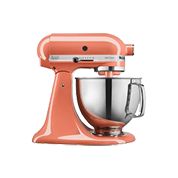Grain Mill Tips
Tips for Using the KitchenAid Grain Mill
What can I grind?
The Grain Mill Attachment is designed for low-moisture, non-oily grains such as wheat, corn, rye, oats, rice, buckwheat, barley, and millet.
All these low-moisture, non-oily grains may be ground in your KitchenAid grain mill:
- WHEAT: Hard wheat, with a high percentage of protein, is generally considered best for bread flour; soft wheat is preferred for cakes, cookies, and other baked goods. Mix hard and soft wheat for all-purpose flour.
- CORN: Grind fine for baking, coarse for cornmeal mush.
- RYE: Combine rye flour with wheat flour for best results with rye bread; rye does not contain enough gluten for good rising.
- OATS: Oats must be hulled before grinding for flour, or use rolled oats. Oat hulls block proper feeding of grain into grinding burrs. In most recipes, you can substitute oat flour for up to 1⁄3 of the all-purpose flour.
- RICE: Both white and brown rice grind well.
- BUCKWHEAT: For best results, buckwheat should be hulled before grinding. Raw and toasted buckwheat both grind well.
- BARLEY: For best results, barley should be hulled before grinding.
- MILLET: Before grinding, toast millet in a heavy, dry skillet to bring out this very small grain’s unique flavor. Stir constantly to avoid burning.
Do not grind:
- Coffee beans: their high oil content can damage the grinding mechanism.
- Grains or nuts with a high moisture or oil content, such as sesame seeds, peanuts, sunflower seeds, and soybeans.
How much can I grind?
Do not grind more than the equivalent of 10 cups of flour on Speed 10 at one time without allowing the mixer to cool for at least 45 minutes before using it again.
- One cup of most grains yields approximately 1 ¼ - 1 ½ cups of flour.
- One cup of oats yields approximately 7/8 cup of flour.
Consistency of grind
At the finest setting, the consistency of the flour will not be as fine as store-bought white flour, but more comparable to fine cornmeal. This is because the mill is using the entire grain berry, including the bran that is removed for white flour. Commercial grinders sift out some parts of the berry before marketing the flour.
When grinding corn or other types of hard grains, to achieve a finer grain, it may be necessary to start at a higher/coarser level followed by a second grind at a finer level.
The original grain mill (GMA) did not grind as finely as the later models KGMA and KGM.
Storing fresh flour
If you grind more flour than your recipe requires, store it in the refrigerator or freezer to prevent it from becoming rancid, since this product contains no preservatives.
Still need help? Contact us or schedule service.
Please contact us or click below to make an appointment from our preferred list of service providers for service on your appliances.
United States
Canada
Interested in purchasing an Extended Service Plan?
Please click below to learn more on how you can save up to 25% on New Appliance Extended Service Plans within 30 days of your appliance purchase.
United States
Canada
Still need help? Contact us or schedule service.
Please contact us or click below to make an appointment from our preferred list of service providers for service on your appliances.
United States
Canada
Interested in purchasing an Extended Service Plan?
Please click below to learn more on how you can save up to 25% on New Appliance Extended Service Plans within 30 days of your appliance purchase.
United States
Canada










.png)

























